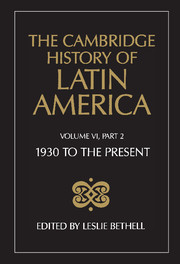3 - The Left in Latin America since c. 1920
from Part Two - Politics
Published online by Cambridge University Press: 28 March 2008
Summary
The simplest way of writing the history of the Left in Latin America would be to restrict analysis to Communist and Socialist parties. These parties shared common ideological assumptions drawn from Marxism, and common political practices influenced by Leninism. If there was broad agreement about ends, however, the parties of the orthodox Marxist Left profoundly disagreed about means. This led to conflict and division. Between, and indeed within, the parties of the Left there was fierce, and often unresolved, debate over how power was to be attained, the extent to which liberal democratic rights should be respected, and the way that economy, society and the political system should be organized. In other words, there neither was, nor is, one united Left. Relations between the many groups, parties and movements that have claimed to be the true Left have frequently been hostile, even violently so. Competition between them has sometimes been more intense than with the parties of the Right. If the story of the Left is in part a story of heroic and patient struggle against terrible odds, it is also in part a story of sectarianism and personal rivalries, and of petty mindedness. It is nevertheless a story central to the political development of most Latin American countries in the twentieth century.
Defining the Left solely in terms of parties of Marxist inspiration and structure is, as will be argued, incomplete. None the less, the starting point for any historical discussion of the Left in Latin America has to be the Communist parties of the various republics.
- Type
- Chapter
- Information
- The Cambridge History of Latin America , pp. 163 - 232Publisher: Cambridge University PressPrint publication year: 1995
References
- 14
- Cited by

